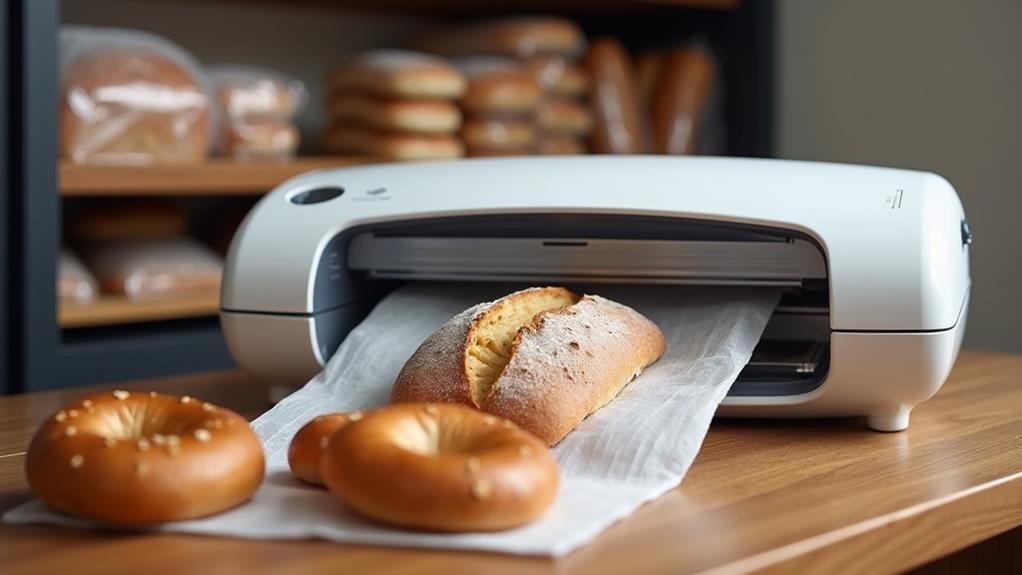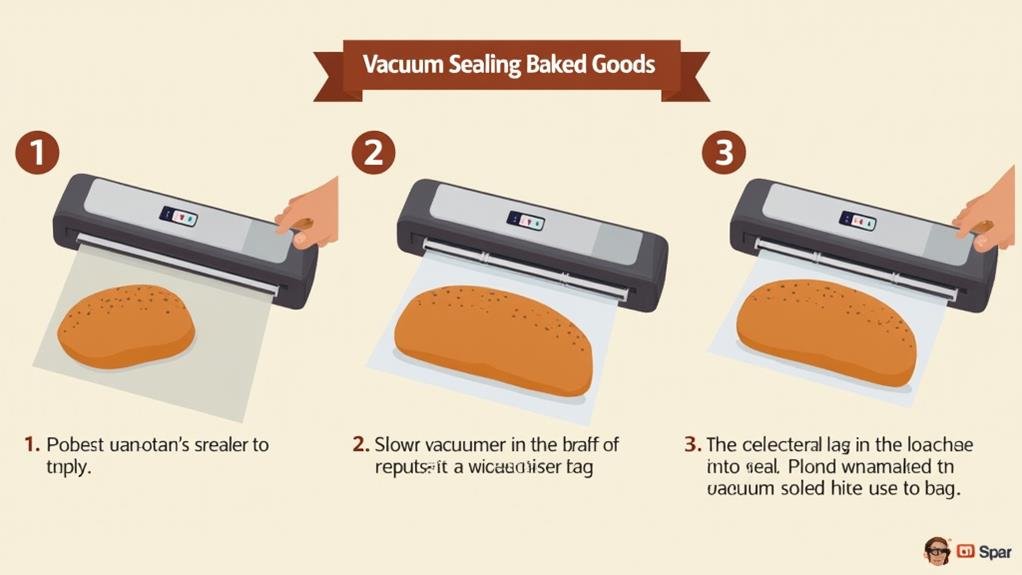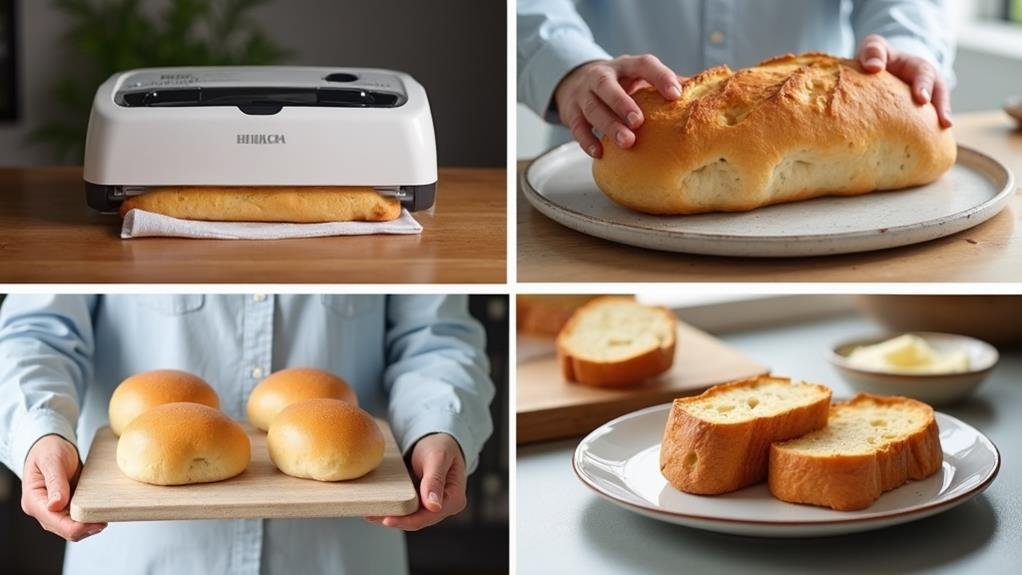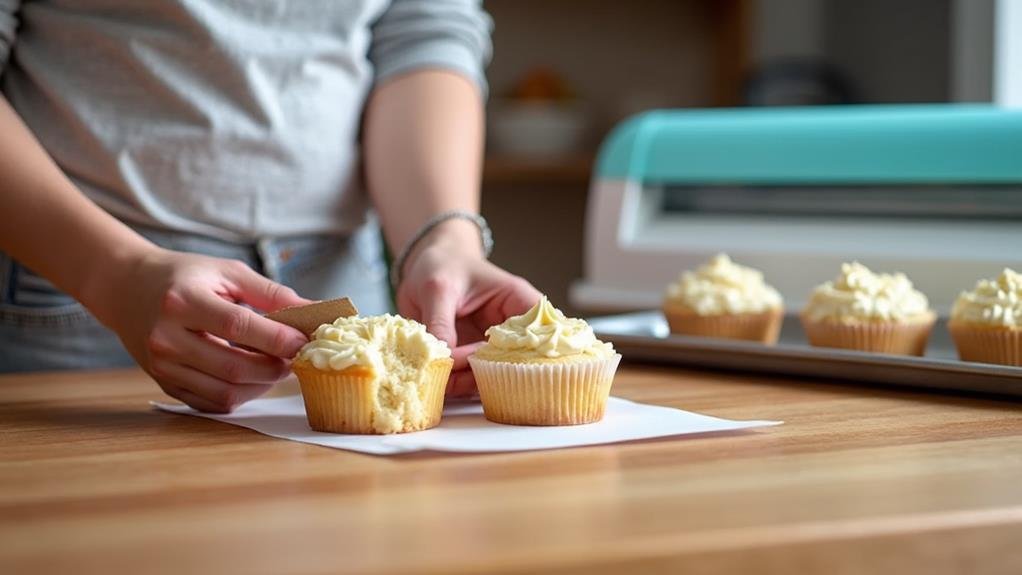As I wrap my hands around a warm, freshly baked loaf, the aroma transports me to a cozy bakery, but the reality of its short shelf life soon sets in. However, there's a secret to prolonging this bliss: vacuum sealing. By removing the air and creating an airtight seal, you can significantly extend the freshness of your baked goods. But how does it work, and what are the best practices to enhance the freshness of your baked goods? Let's explore the world of vacuum sealing and uncover the tips to keep your baked treasures fresh for months to come.
Benefits of Vacuum Sealing

When you vacuum seal baked goods, you create an airtight environment that slows down the staling process. This is particularly beneficial for items like bread, where freshness is essential for maintaining its taste and structure. However, it should be mentioned that some foods, such as soft cheeses, bread, and high moisture items, should not be vacuum sealed as this can alter their taste and promote spoilage. Vacuum sealing also inhibits bacterial growth, keeping your baked goods safe for consumption. This method protects against contaminants and prevents the absorption of moisture, which can lead to spoilage or drying out.
Furthermore, proper vacuum sealing protects baked goods from freezer burn when stored in the freezer. This guarantees that your items retain their texture, flavor, and nutrients over a longer period. Considering factors like cookie types, ingredients, and textures is crucial for successful vacuum sealing, but the overall benefits are evident: vacuum sealing is a practical and efficient way to maintain the freshness and safety of your baked goods.
Essential Tools and Materials
To get started with vacuum sealing your baked goods, you'll need a few important tools. First, a reliable vacuum sealer is essential for removing air and creating an airtight seal. You'll also need vacuum sealer bags that are durable, freezable, and microwave-safe to guarantee your baked goods are properly packaged.
Essential Tools
To effectively vacuum seal baked goods, you need the right tools and materials. The primary tool you'll need is a vacuum sealer, which removes air from the bags or containers to create an airtight seal. This process is important for preventing oxidation, moisture, and the growth of microorganisms that can spoil your baked goods.
Along with the vacuum sealer, you'll require vacuum sealer bags or rolls that are durable, freezable, and microwave-safe. These bags come in various sizes, including pre-cut bags and rolls that allow you to create custom sizes, reducing waste and accommodating different types of baked goods.
Additional tools include a cooling rack to make sure your baked goods are completely cooled before sealing, which is essential to prevent moisture from accumulating inside the bag. Markers or labels are also necessary for properly labeling and organizing your vacuum-sealed baked goods, making it easier to identify what you have stored and when it was sealed.
Investing in quality tools and materials for vacuum sealing can greatly extend the shelf life of your baked goods, maintaining their flavor, texture, and overall quality for longer periods. By using these essential tools, you can ensure successful preservation of cookies, bread, cakes, and more through the vacuum sealing process.
Vacuum Sealer Bags
Vacuum sealer bags play a vital role in preserving baked goods, and selecting the appropriate ones can make a world of difference in maintaining their freshness and quality. These bags are crafted from high-barrier materials that are engineered to keep air out, which is pivotal for preventing oxidation and the proliferation of microorganisms like bacteria, yeast, and mold.
When vacuum sealing baked goods such as cookies, using bags that are compatible with your vacuum sealer is imperative. The correct bag size ensures an ideal seal, preventing air from infiltrating back into the bag and compromising the freshness of your baked goods. For example, if you're sealing cookies, freezing them solid before vacuum sealing can assist them in retaining their shape and avoiding breakage during the sealing process.
Vacuum sealing baked goods in these high-barrier bags significantly prolongs their shelf life. By eliminating air from the bag, you decelerate the staling process, keeping your cookies fresh for a longer duration. Moreover, labeling the bags with markers aids in identifying the contents and the date of sealing, simplifying the management of your stored items.
Packaging Preparation
When preparing to vacuum seal baked goods, having the right tools and materials is essential for maintaining their freshness and quality. A vacuum sealer is the cornerstone of this process, as it removes air from the packaging, inhibiting bacterial growth and extending the shelf life of your baked goods.
In addition to the vacuum sealer, you will need vacuum sealer bags that are compatible with your machine. These bags are designed to be airtight, ensuring that once the air is removed, the contents remain fresh. A cooling rack is also important for allowing your baked goods to cool completely before sealing, as sealing hot items can lead to moisture buildup and reduce the effectiveness of the seal.
Markers and labels are equally significant for properly labeling the vacuum-sealed bags. This guarantees easy identification of the baked goods and helps you track storage times for optimal freshness. Using these tools correctly is vital for successful vacuum sealing, preserving the quality and taste of your baked goods.
Step-by-Step Sealing Guide

Before you start sealing your baked goods, make sure they have cooled completely to prevent moisture from interfering with the sealing process. This step is essential because excess moisture can lead to poor sealing and potentially spoil the food.
To start the vacuum sealing process, you will need a high-quality vacuum sealer and bags specifically designed for food preservation. Place your cooled baked goods in the vacuum sealer bag carefully to ensure best sealing. Make sure the items are arranged in a way that allows the sealer to remove air effectively.
Initiate the vacuum sealing process according to your sealer's instructions. This involves placing the open end of the bag into the sealer and closing it, then starting the machine. The vacuum sealing process removes air from the bag, which helps preserve the freshness of the baked goods by preventing oxidation and the growth of microorganisms.
Once the bag is sealed, label it with the contents and the date. This is important for keeping track of what you have stored and for how long. Now, your vacuum-sealed baked goods are ready to be stored in the pantry or freezer, maintaining their freshness for a longer period.
Tips for Effective Sealing
When vacuum sealing baked goods, it's essential to follow a few key tips to preserve freshness, prevent stale bread, and extend shelf life. First, make sure to shake off loose crumbs before sealing to prevent them from affecting the sealing process. Using high-quality vacuum sealer bags specifically designed for preserving baked goods and avoiding overfilling the bags are also necessary for ensuring a strong and effective seal.
Preserving Freshness
To effectively maintain the freshness and flavor of your baked goods, such as cookies, bread, and bagels, vacuum sealing is a highly efficient method. This process works by removing air from the packaging, which reduces oxidation and inhibits the growth of microorganisms like bacteria, yeast, and mold. Here are some key points to keep in mind:
- Remove Air to Preserve Quality: Vacuum sealing eliminates air, which is essential for maintaining the freshness and flavor of baked goods. This method slows down the staling process and keeps the items fresh for a longer period.
- Use High-Quality Bags: Quality vacuum sealer bags are crucial for effective sealing and preserving the texture and taste of your baked goods. These bags provide a strong, airtight seal that prevents moisture and oxygen from affecting the items.
- Seal When Fresh: Vacuum sealing should be done when the baked goods are fresh to maximize the extension of their shelf life. Freshly baked items sealed promptly retain their freshness and flavor better than those sealed after they have started to stale.
- Avoid Overfilling: Overfilling the bags can compromise the seal and the preservation of the baked goods. Ensuring the bags are not overfilled helps in achieving a strong seal and best preservation.
Preventing Stale Bread
Preventing stale bread is an important benefit of vacuum sealing, especially for those who bake frequently or purchase fresh loaves. Vacuum sealing bread prevents staleness by removing air and inhibiting mold growth, which are key factors in bread going stale.
To maintain ideal freshness preservation, it's crucial to pre-cool your baked goods before sealing. Allow the bread to cool completely to room temperature to prevent moisture buildup and condensation inside the package. This step is necessary for maintaining the bread's texture and flavor.
Proper sealing techniques, such as using quality vacuum sealer bags, are also essential. High-quality bags ensure a secure seal, preventing air from re-entering the bag and spoiling the bread. Avoid overfilling the bags, as this can affect the sealing process and compromise the freshness of the bread.
Vacuum sealing bread can keep it fresh for up to three years when stored in the freezer, which is notably longer than traditional storage methods. Labeling the sealed bags with the contents and dates helps you track freshness and usage, making it easier to manage your stored bread effectively.
Extending Shelf Life
To extend the shelf life of your baked goods effectively, following a few key steps is crucial when using a vacuum sealer.
Vacuum sealing is a powerful method for preserving the freshness and quality of your baked goods. By removing air from the packaging, you inhibit the growth of mold, prevent staleness, and protect against freezer burn. Here are some essential tips to keep in mind:
- Immediate Sealing: Vacuum seal your baked goods as soon as they have cooled down. This guarantees that the initial freshness is locked in and helps prevent any deterioration.
- Proper Storage: Store vacuum-sealed baked goods in the suitable environment. For example, cookies and pastries can last up to 2 years when stored in the freezer, while they may last several months when kept in a cool, dark pantry.
- Maintain Integrity: Make sure the vacuum seal is tight and intact. Any air leakage can compromise the effectiveness of the vacuum sealing, allowing oxygen to intrude and potentially leading to spoilage.
- Choose the Right Settings: Adjust the vacuum sealer settings according to the type of baked goods you are sealing. For instance, soft or delicate items may require a gentler vacuum setting to prevent damage.
Storing and Freezing Techniques

When it comes to storing and freezing baked goods, vacuum sealing is a game-changer. This method not only helps preserve freshness and flavor but also extends the shelf life of your baked items significantly. Vacuum sealing can also help diminish food waste considerably by keeping your baked goods fresh for longer periods.
Properly stored and vacuum sealed baked goods, such as bread, cookies, and cakes, can last much longer in the freezer. To achieve this, it's vital to pre-freeze the baked goods before vacuum sealing. Freezing them solid helps maintain their shape and texture, preventing damage during the sealing process.
Vacuum sealing reduces the risk of freezer burn and helps maintain the texture of the baked goods. By eliminating air from the package, you create an airtight environment that slows down the staling process and prevents the growth of microorganisms.
For convenient consumption, you can use a vacuum sealer to store baked goods in individual portions. This way, you can easily retrieve and use what you need without having to thaw the entire batch.
Preserving Different Baked Goods
Vacuum sealing is a versatile method that can be applied to a wide range of baked goods, each with its own specific things to keep in mind for best preservation. When it comes to preserving different baked goods, vacuum sealing stands out as an effective technique for maintaining freshness, flavor, and texture. This method not only enhances food safety but also minimizes exposure to harmful chemicals commonly found in traditional storage methods, making it a healthier choice for long-term preservation avoiding harmful chemicals. Here are some key points to note:
- Bread and Bagels: Vacuum sealing slows down the staling process by creating an airtight environment, preserving the shape and structure of the bread. This method is particularly useful for homemade loaves and bagels, allowing them to stay fresh for longer periods.
- Cookies: To vacuum seal cookies, it is advisable to freeze them first to prevent breakage during the sealing process. This helps in maintaining their texture and freshness, especially when shipping them over long distances.
- Cakes and Pastries: These delicate items require careful handling to avoid damage. Freezing before vacuum sealing can help preserve their texture and prevent them from getting crushed or deformed.
- Preventing Freezer Burn and Contamination: Vacuum sealing removes oxygen from the packaging, which prevents freezer burn and contamination, thereby extending the shelf life of the baked goods significantly.
Common Mistakes to Avoid**

When vacuum sealing baked goods, it's vital to be mindful of several common mistakes that can compromise the integrity and freshness of your items.
Firstly, avoid vacuum sealing delicate or soft baked goods like cakes or muffins, as the process can cause them to flatten or become distorted. If you must seal such items, consider freezing them first and using a protective layer, such as a piece of cardboard or wax paper, to prevent damage.
Another crucial mistake is sealing baked goods with sharp edges or toppings that can puncture the vacuum sealing bags. This can lead to leaks and render the seal ineffective. Make sure that any items with sharp edges are wrapped or protected in a way that prevents them from damaging the bag.
It is also essential to guarantee that your baked goods are completely cooled before vacuum sealing. Sealing hot or warm items can lead to condensation inside the bag, which can promote mold growth and spoilage.
Overfilling the vacuum sealing bags is another common error. Leave enough space around the baked goods to allow for a proper seal. Overfilling can make it harder to seal the bag and may result in leaks or spills.
Frequently Asked Questions
How Long Do Baked Goods Last Vacuum Sealed?
Imagine your baked goods staying fresh for what feels like an eternity When vacuum sealed, they can last up to 1-3 years in the freezer and 1-2 weeks in the fridge, retaining their flavor and texture remarkably well.
What Foods Should Not Be Vacuum Sealed?
When it comes to vacuum sealing, there are several foods I avoid to maintain safety and quality. These include soft cheeses, raw mushrooms, garlic, onions, fermented foods, and vegetables like broccoli and cabbage, as they can host anaerobic bacteria or release gases that cause spoilage.
How to Vacuum Seal Cookies Without Breaking Them?
To vacuum seal cookies without breaking them, let them cool completely first. Use a vacuum sealer with a gentle or manual setting to avoid crushing. Leave a little air cushion in the bag or pre-freeze the cookies for added protection.
Is It OK to Vacuum Seal Cooked Food?
Yes, it's okay to vacuum seal cooked food. This method extends shelf life by removing air, reducing spoilage, and maintaining freshness, flavor, and texture. Just guarantee proper sealing and storage to avoid any food safety risks.
Conclusion
Vacuum sealing baked goods is a game-changer for extending their freshness and quality. While you might worry about the environmental impact of using plastic bags, consider investing in reusable vacuum bags or exploring eco-friendly alternatives. This small adjustment can notably reduce food waste and save you money in the long run. With the right tools and a little practice, you can keep your baked goods fresh for much longer, making every bite as delicious as the day it was baked.
